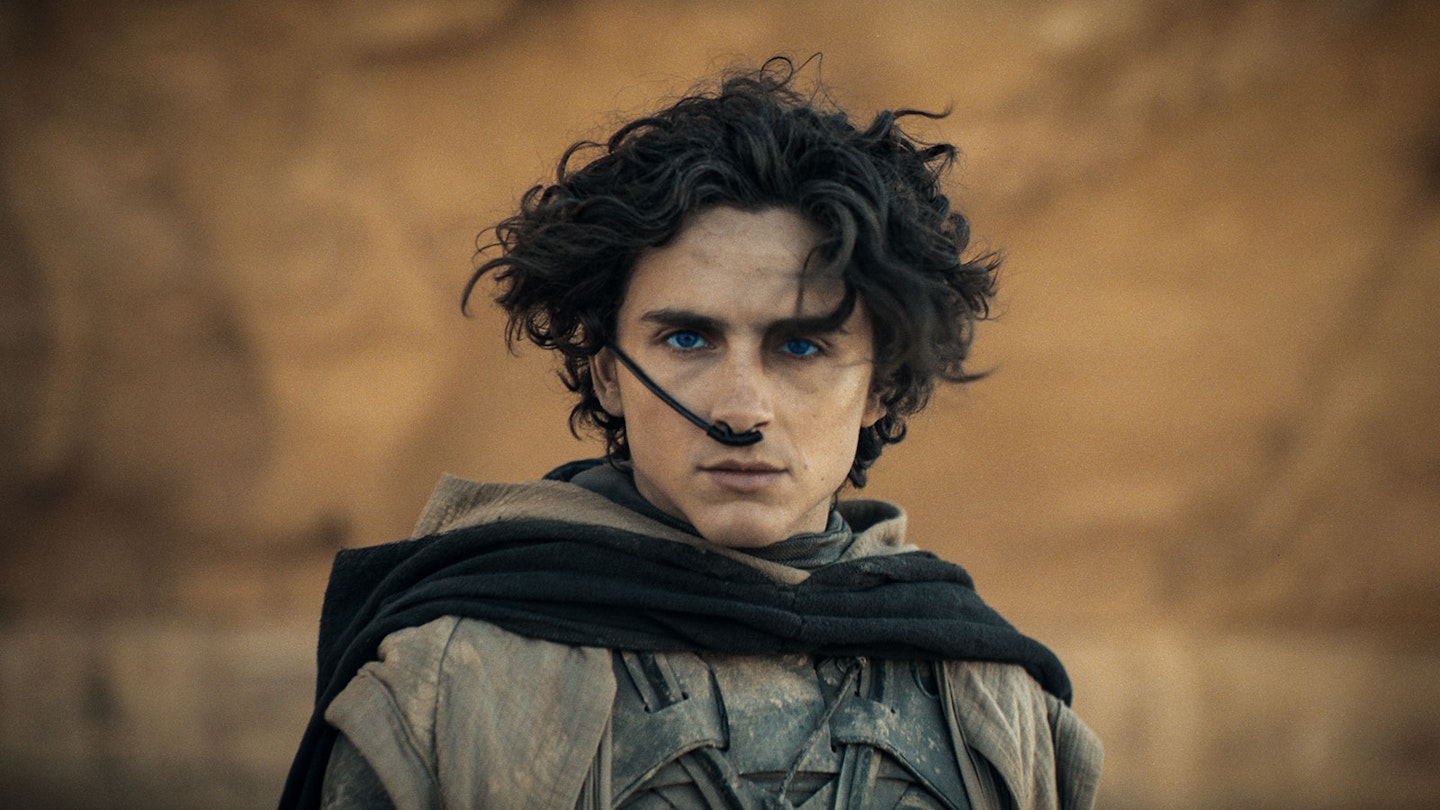Denis Villeneuve’s Dune was a miracle – a gorgeous, intelligent blockbuster that took us to a startling new world. Now, as he puts the finishing touches to Dune: Part Two, he tells us how everything’s about to get weirder… and wormier.
On the planet Arrakis — or the deserts standing in for it, at least — three men were searching. Hunting. For the perfect type of sand.
Arrakis, home to the Spice, is felt in every breath of Frank Herbert’s original Dune novel. An inhospitable, barren world, home to humongous worms and winds that can cut metal, its unique character forms the heart of the entire story. Which is why, for Dune: Part Two, director Denis Villeneuve, cinematographer Greig Fraser and production designer Patrice Vermette spent an inordinate amount of time trekking through the desert and staring at tiny yellow grains.

“For my mise-en-scène, I’ll want a particular shaped dune. But Greig Fraser, on the other hand, will need that same shape to be in a specific light,” Villeneuve explains. “So Patrice spent weeks and weeks casting sand dunes in the desert! We looked like madmen.”
Sand. It’s coarse, and rough, and irritating, and it gets everywhere. Anakin Skywalker had the right of it, but when you’re shooting a desert epic almost entirely on location, gritty little granules are an unfortunate fact of life. “I still find it every morning in my shoes,” winces the director. “We’re sand-traumatised, for sure.”
Vermette spent months carrying bottles of the stuff around with him on the first film, just to make certain the colour and texture were a perfect match as they hopped between Abu Dhabi’s Liwa desert and the Wadi Rum in Jordan. Now, though, he found himself with the unenviable task of having to start again from scratch. “We didn’t repeat a single location,” he says with pride. “We found completely fresh spots to tell our story this time around.” Every grain, pebble and rocky outcrop was chosen anew for Dune: Part Two. For these filmmakers, fixated with making their return to Arrakis just right, there was no length to which they would not go.
“Austin Butler brought something that is a cross between a psychopath killer, an Olympic sword master, a snake, and Mick Jagger"
Many months later, in August 2023, Villeneuve is in his edit suite in Burbank, Los Angeles — a place entirely devoid of sand — taking a few hours’ respite to talk to Empire. The cut, sound and VFX for his sequel are very much works in progress, but the closing half of his adaptation of Herbert’s ‘unfilmable’ book is inching its way slowly towards completion. “The movie is alive!” says Villeneuve excitedly. “Part One was like the promise of something, but Part Two delivers on that. I’m exhausted, but a happy director.”
Dune’s was a promise that came within a sandworm’s whisker of not being kept at all, however. Irrespective of the ‘Part One’ Villeneuve dropped into the first film’s title, the movie arrived in cinemas with no guarantees. “This is only the beginning,” teased Zendaya’s Fremen warrior Chani in the closing moments, but over that hung an ominous, all-too-likely possibility that this lovingly crafted saga might never have an ending.
“Shooting that final scene, I remember saying to myself, ‘Well, at least I have lived on Arrakis with these characters. And if that’s it, then so be it,’” says Villeneuve. “I was at peace with the idea… but it would have been very awkward to stop there.”
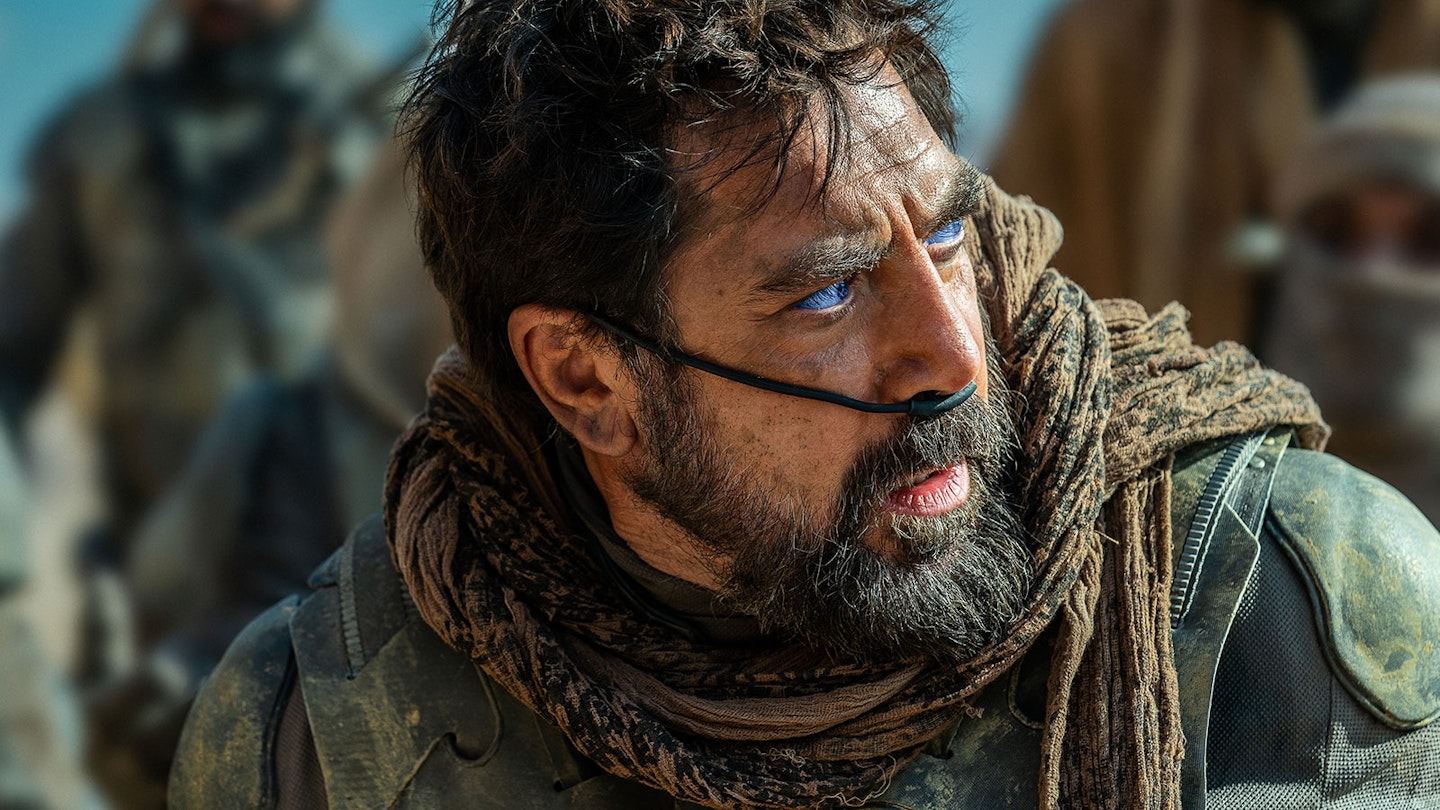
Delayed a full year from its original 2020 launch by the pandemic and then condemned to a controversial day-and-date release on HBO Max, Villeneuve’s epic, already a big swing, seemed doomed before ever having seen the light of day. “It was like going to a race with a massive weight attached to each of your feet,” he recalls. But then something magical happened. His immersively cinematic, almost meditative film lured wary, mask-wearing people out of isolation and reminded them of the transportive power of cinema. It whisked them away to the planet Arrakis and let them feel the sand between their toes, as Timothée Chalamet’s Paul Atreides embarked on a journey of self-discovery against the backdrop of an arid desert world.
Despite the odds stacked against it, the film cashed out with over $400 million and earned ten Oscar nominations. It was officially a story worth finishing. Thus, the morning after the 2022 Academy Awards, Villeneuve boarded a plane to go and do it all over again. The desert was calling.
***
Dune: Part Two has allowed Villeneuve to go bigger, with the spectacle and with the increasingly sprawling cast. It’s also allowed him to go deeper. Just take the musical number that was cut from Part One. Not a rousing medley of Harkonnen baritones and Atreides tenors, with Fremen backing dancers twerking across the desert. But rather a simple, mournful ballad sung by Josh Brolin’s Gurney Halleck, with accompaniment on the lute-like baliset — an instrument invented by Frank Herbert. Die-hard Dune fans no doubt mourned the famed instrument’s omission, but none felt its loss more keenly than Villeneuve himself. Which is why the director’s face is currently split by a grin so wide, it could swallow a spice harvester whole. “The Gurney song survived Part Two!” he declares with childlike glee. “It became a weird priority for me. But Josh Brolin is a poet and we played it together. It was awesome.”
The sequel delves further into Herbert’s wild world, and not just musically, making for a distinct tonal shift. “The first movie was more contemplative — a young man discovering a world. Here, it’s a war movie,” says Villeneuve. “But at the very core is a love story between Paul and Chani. How Paul will gain her trust, how she will open her heart to him, and how they will find a way to free Chani’s world from the Harkonnen grip. It’s a much more emotional movie.”
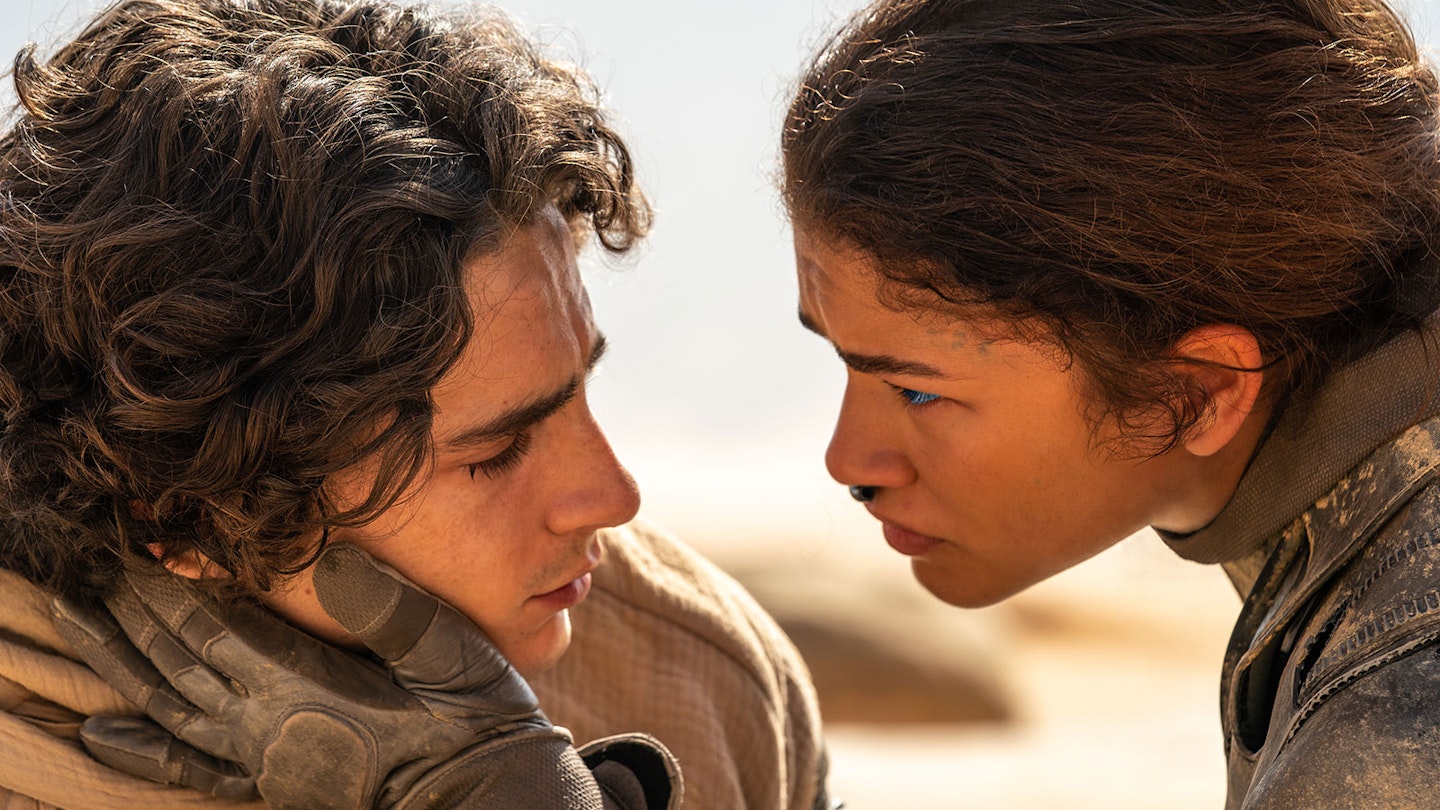
Zendaya’s Chani is an elusive, almost ethereal presence in Part One, infiltrating Paul’s dreams, the pair only meeting at the film’s finale. Now, Chani’s growing connection to the callow youth with wisdom beyond his years proves as powerful as it is discomfiting — her people having a deep hatred of outlanders born from generations of colonial oppression. Paul, meanwhile, now Muad’Dib — his Fremen name taken from a small desert mouse that haunts the sands — emerges not just as a leader to her people, but as a messianic seer, touched by prophesy.
“I remember when I was doing Part One, I kept saying to Timothée, ‘No, you’re just Paul.’ Because he was reaching for Muad’Dib. He was looking forward to becoming that hero and I was pushing the brakes,” says Villeneuve with a laugh. With that innocence now firmly lost, Part Two sees Paul’s destiny realised, his transformation into the emblematic figure of legend finally coming to bear. “He has the power to change things, but he knows that if he does so, it will create an astronomical amount of violence and he will become a kind of dictator. He’s trying to find a way to avoid that ominous future — that’s the burden upon his shoulders.”
It’s Paul’s immediate future, however, that harbours a far more pressing and deadly threat.
***
Despite the blinding desert sun, a vast, dark shadow hung over Dune: Part One: the Padishah Emperor, Shaddam IV, who sits on the Golden Lion Throne on distant Kaitain, and whose vanity led him to orchestrate the fall of House Atreides. Villeneuve and co-writers Eric Roth and Jon Spaihts withheld the Emperor’s presence from the first film, allowing his far-reaching influence to speak bloody volumes instead. Here, the gilded ruler of the known universe finally takes centre stage, embodied, as all great leaders should be, in the form of Christopher Walken — as was foretold by the prophet Fatboy Slim.
“When they asked me who I saw as the Emperor, spontaneously I said to the studio, ‘I see Christopher Walken,’” Villeneuve recalls. “He’s a force. There’s something about that man that commands respect. The way he acts, it’s explosive, it’s absolutely unpredictable, poetic and powerful. When he came on set, I was frightened!”
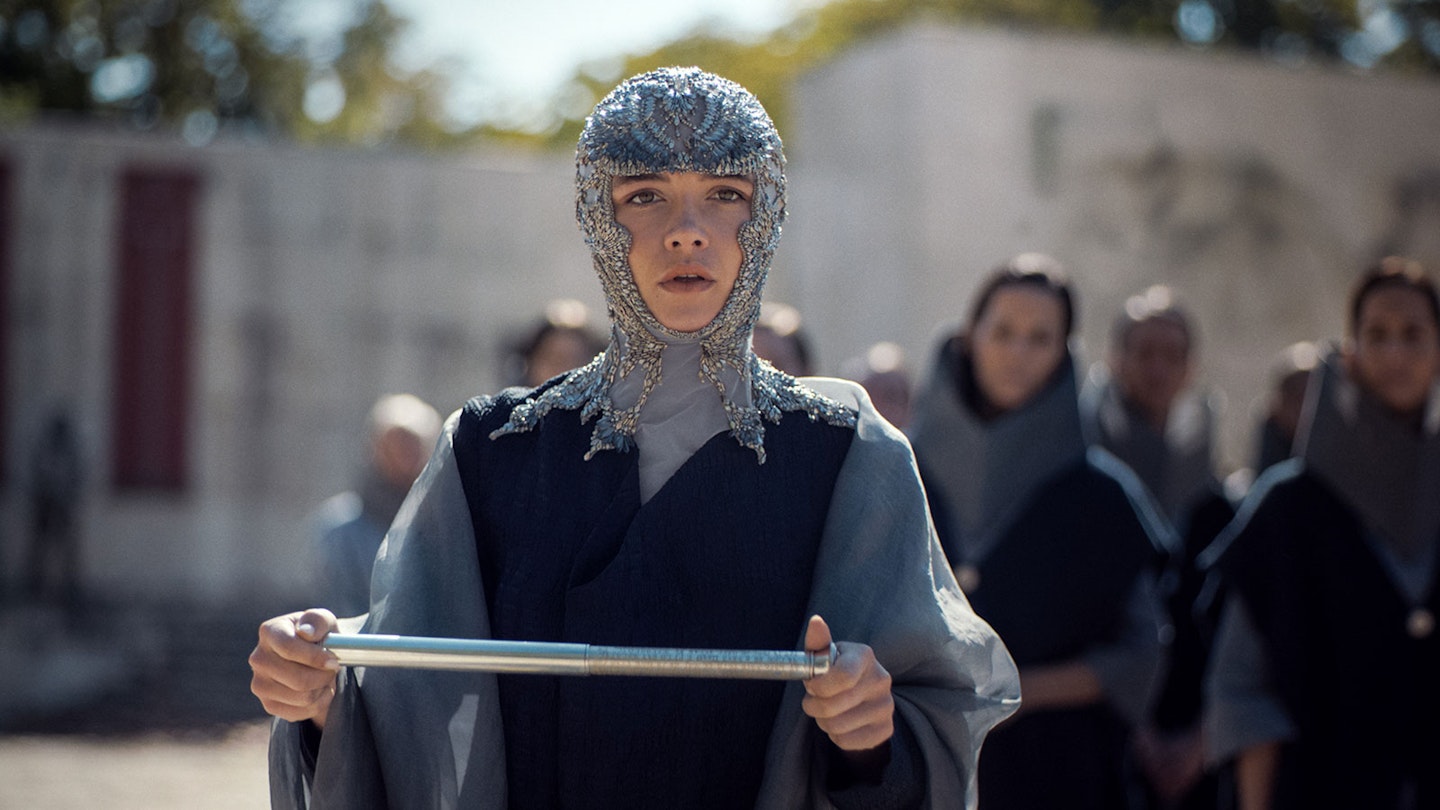
A technocrat whose political power conceals a deep-rooted insecurity (“He’s a wounded man, full of regrets”), the Emperor’s inner weakness is balanced by the leonine strength of his daughter, Irulan — a character who provides the epigraphs to each chapter of Herbert’s book and who narrated (via Virginia Madsen) much of David Lynch’s 1984 film. Here, she comes in the form of an ornately bedecked Florence Pugh, a harsh metal face-veil lending her an aesthetic that’s part princess, part Cenobite. Pugh (whose on-screen reunion with Chalamet is a touch more fraught than Little Women’s genteel engagement) was tasked with ensuring the Corrino princess is seen as neither object nor victim. Something Villeneuve focused on in the writing phase, too. “I had to make sure we understand that, at the end of the day, she’s a Bene Gesserit more than anything else,” he says of her place in the occult sisterhood. “She’s not an instrument of the Imperials — she’s a part of the bigger plan.”
House Corrino doesn’t only bring with it new pieces, however, but a whole new board to play upon. A counterpoint to Arrakis’ earth-toned wastes, the Emperor’s homeworld is a verdant paradise — as far removed from the harsh, wind-carved stone and Brutalist architecture of Arrakis city Arrakeen as it’s possible to get. Subbing for Kaitain in the film is Italy’s Brion Tomb in the Grappa Mountains, a modernist mausoleum set amongst lush gardens and gushing fountains, designed by Venetian architect Carlo Scarpa. “It’s actually the first location I’ve visited in my life where I cried walking in,” admits Vermette.
"When I came to work here in Los Angeles more than ten years ago, people kept asking me, ‘What would be your dream if you could pick one thing in all the world?’ And I kept saying, ‘Dune.’"
Even Arrakeen isn’t quite what it was, however. After being carpet-bombed by the Harkonnen, the capital is, understandably, much changed. With Glossu ‘The Beast’ Rabban (Dave Bautista) back in control, the occupying force has brought the industrialised, artificial feel of their home, Giedi Prime, to the city. “A fake, plastic world influenced by the aesthetic of septic tanks,” says Vermette. “They implement their force upon the Fremen by spreading their aesthetics and their culture just like a cancer.”
The Harkonnen are brutal, totalitarian colonialists, to be sure, but basic they are not. Twisted and warped, yes, but there’s a perverted sophistication to their hedonistic ways that, Villeneuve insists, makes them the most advanced culture of all. “If there’s a party somewhere that you want to attend, it’s on Giedi Prime,” laughs the director. “These guys know how to throw a party, but they are not meant to be on Arrakis. They hate the planet, they hate the people, they’re just there for the money. That’s where their weakness is.”
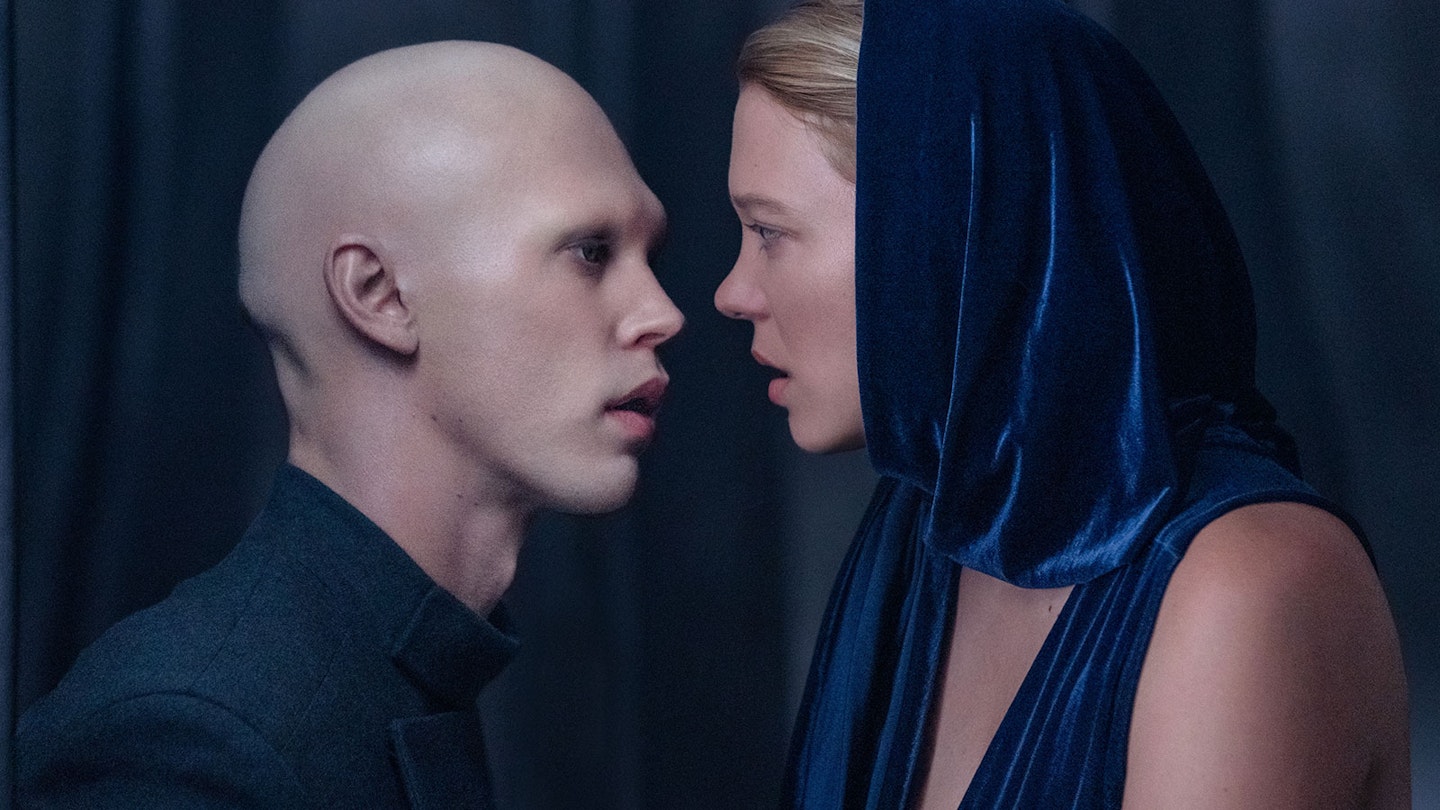
There is no such deficiency anywhere near Austin Butler’s Feyd-Rautha. Baron Harkonnen’s second nephew, Feyd is everything that Rabban isn’t: shrewd, sexy, cunning and subtle as an envenomed blade. Another character deliberately held back for Part Two, Feyd appears more alien than man, with a piercing, animalistic mien imposed over his follicle-free complexion. “I like to think that, as a culture, Harkonnens don’t like hair!” quips Villeneuve. Regular full-body waxes would certainly explain their disposition.
Butler was recommended to Villeneuve by an enthusiastic Baz Luhrmann, who called him in to watch some early Elvis footage to seal the deal. Given that the world’s experience of Feyd-Rautha to date has, infamously, been a smirking, cockatoo-haired Sting wearing a winged blue codpiece in Lynch’s version, Butler is a significant upgrade. “Austin brought something that is a cross between a psychopath killer, an Olympic sword master, a snake, and Mick Jagger,” says the director. “He has tremendous sex appeal and charisma and madness. It’s really out there.”
Unleashed by the Baron as a direct response to Paul’s ascendence, Feyd-Rautha is similar to the young Duke in many ways: charismatic, intelligent, and a gifted tactician — but merciless, with a cruel streak a mile wide. He is the Harkonnen’s secret weapon in quelling the budding Fremen insurgency, and a deadly one. But keen as the edges on Feyd-Rautha’s twin blades may be, only a fool brings a knife to a worm fight…
***
Shai-Hulud. The Maker. Old Father Eternity. The gargantuan annelids of Arrakis’ dune sea go by many names. Worshipped as a god by the native Fremen, they are the planet’s apex predators, nearly half a kilometre in length, an awe-inspiring force of nature capable of devouring anything in their path. “Or a very, very intense Uber,” laughs Villeneuve.
Harnessed by the Fremen as an alternative to public transport, the prodigious worms are not just a commuter’s friend, or a weapon of mass destruction, but a rite of passage. Fremen do not truly achieve adulthood until they learn to summon and ride Shai-Hulud, and one of the book’s most iconic scenes places Paul in the unenviable position of being forced to step up.
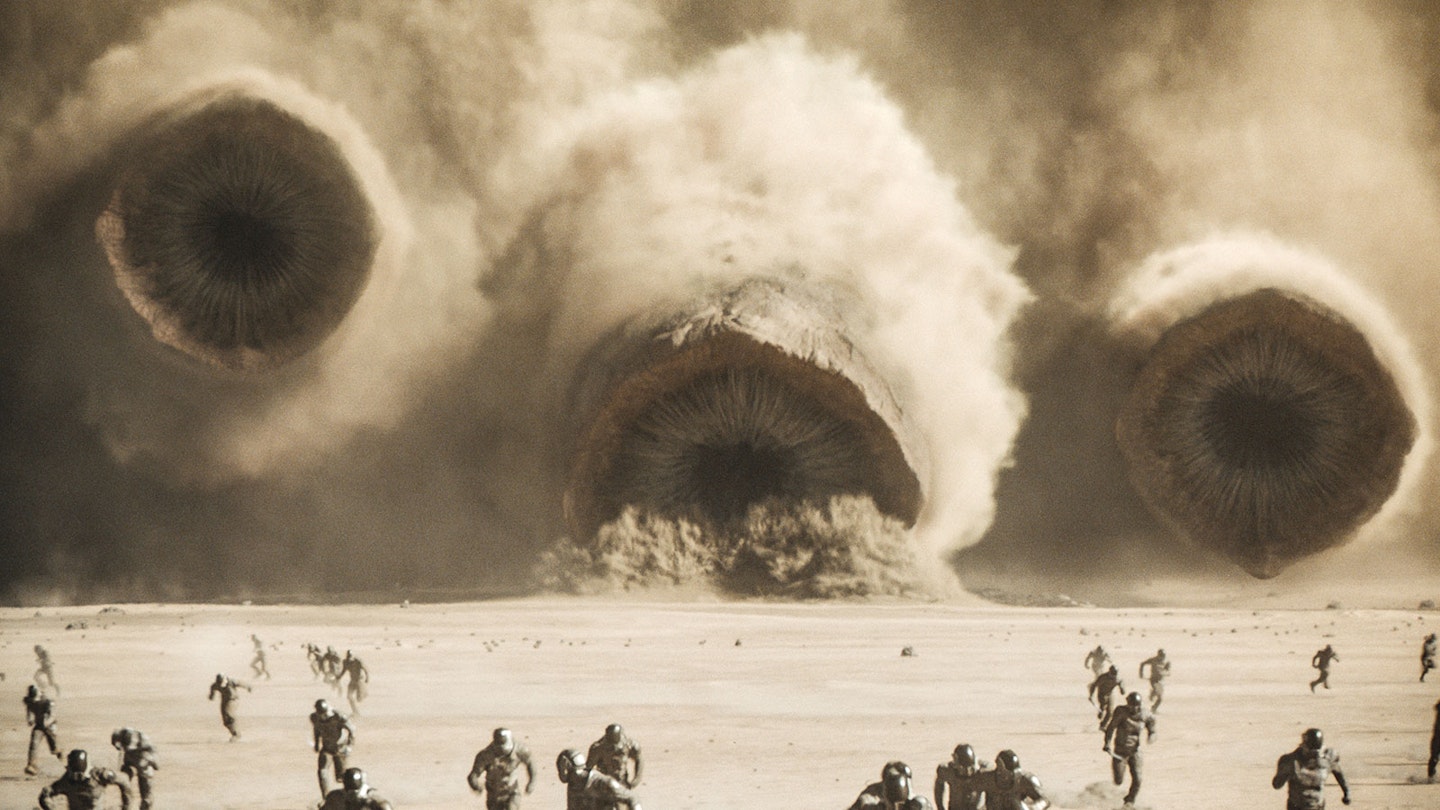
A hand-picked crew dubbed ‘The Worm Unit’ shot the sequence full-time over the course of three months, the team re-examining everything they thought they knew about the desert’s kaiju-sized invertebrates and trying — somehow — to ground the idea of vermian transportation in something approaching reality. “Just because there are no real sandworms, doesn’t mean we’re going to go on to a soundstage,” says Fraser. “We were outside shooting sandworms in the real sun with real wind and real dust. Just because you don’t have one small element, doesn’t mean you throw away the entire concept of being honest and real.”
Realism was similarly at the heart of the Fremen habitat design, their cavernous ‘sietches’ boasting rock-hewn architecture drawing upon desert insects and animals but, crucially, without a single blue-screen in sight. “You know what you get when you take a big blue-screen out to the desert? You get a big blue bounce!” says Fraser. “Blue doesn’t even exist on Arrakis.” Instead, the production used tan-coloured fabric for anything that needed effects, keeping the correct-coloured light while not going down the LED volume route that Fraser worked with on The Mandalorian. “That was a different kettle of fish when it comes to look and feel,” he explains. “Dune has a lot more tangibility to it. Not to dismiss anything from Star Wars, but the reality was we needed to be able to taste the Spice on the screen.”
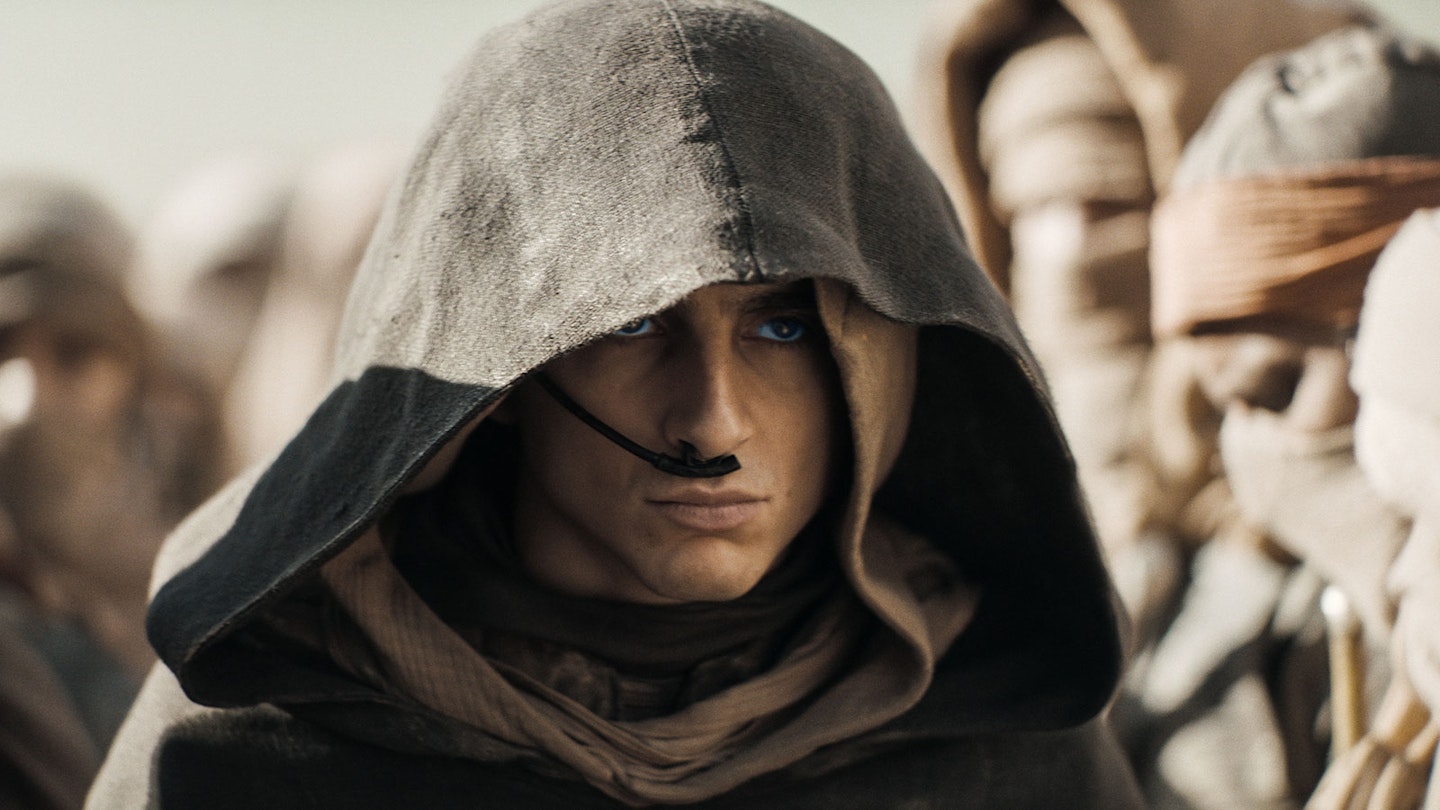
Paul’s induction into this Fremen world is, frustratingly, largely waved off in Herbert’s novel, condensed into a two-year time-jump, after which his mother, Rebecca Ferguson’s Jessica — a member of the Bene Gesserit and arguably the story’s most intriguing character — is all but forgotten. Much as he reveres the original, that was something Villeneuve had no intention of replicating. Why, after all, would you want to skip over all the good stuff? “To adapt is kind of a violent act because you have to omit, to kill, to transform the original material. My version of Dune is different because the thing that really seduced me about the book was the Bene Gesserit. My adaptation is more oriented toward their impact — they are the puppet masters of the universe!” They are the focus that brought Ferguson’s character back to the fore, Villeneuve and Spaihts filling in Herbert’s blanks (“We had a lot of fun imaging Lady Jessica’s journey, it’s one of my favourite parts of the film”). But it also led them to introduce Léa Seydoux as Lady Margot Fenring, a Bene Gesserit mentioned only twice in the novel and whose role Villeneuve has significantly expanded. “I don’t want to talk too much about Lady Fenring,” he demurs. “She’s part of the spider web of the Bene Gesserit, but I want to keep the mystery around her.”
Even those au fait with Herbert’s expansive (and progressively more batshit) bibliography may discover they don’t know precisely how this story ends.
***
Dreams, we are told in the opening moments of Dune: Part One, are memories from the deep, and Denis Villeneuve’s memories of Dune run deep indeed. The director was a smooth-cheeked 13-year-old when he wandered into a small bookshop in Trois-Rivières, near his home in rural Quebec, and was instantly drawn to a striking cover featuring a mesmerising face with cobalt-blue eyes hovering over a landscape of golden sand. “I still remember picking up the book, and as soon as I opened it I was swallowed by this world. It felt like something that had travelled through time and came back to us.”
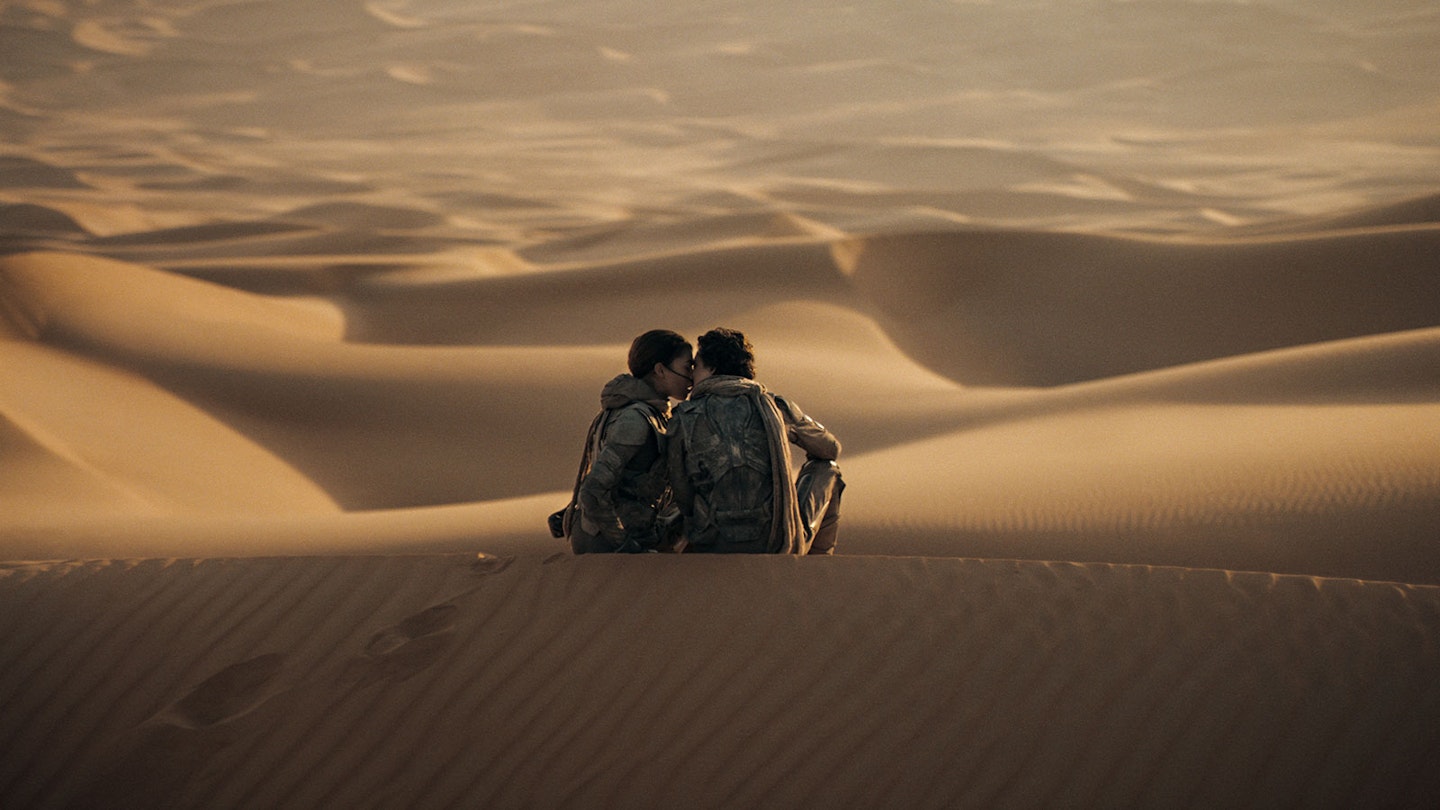
That moment, Villeneuve confesses, was one of the defining moments of his teenage years. “I was a nerd,” he shrugs. That nerd, who had the name ‘Muad’Dib’ furtively engraved on the inside of his school-graduation ring, became obsessed, drawing storyboards of sand-riders and space witches with a close friend. Images that would, four decades later, form the groundwork for his magnum opus. “It’s a book that stayed with me through the years. When I came to work here in Los Angeles more than ten years ago, people kept asking me, ‘What would be your dream if you could pick one thing in all the world?’ And I kept saying, ‘Dune.’ I’m still pinching myself that I’ve had the chance to adapt it. It was exciting, it was fun, but it was also brutal, shooting in rough environments that were extremely hard on the crew. Every day was a challenge — I said that about Part One, but Part Two was even more so.”
The problem with living your dream, however, is the question of what remains when it’s over. Villeneuve admittedly has other irons in the fire: a TV series based on Jo Nesbø’s The Son with Jake Gyllenhaal, an adaptation of Arthur C. Clarke’s Rendezvous With Rama (“Arrival on steroids”), and even a re-telling of Cleopatra. But as to what would make him happiest, what he would do if he had all the choice in the world, there is and can only be one answer: more Dune.
Dune Messiah, Herbert’s (first) sequel, continues the saga of Paul Atreides and is, according to Villeneuve, the only way to properly finish this story. “When he wrote the first Dune, I think he was destabilised by how people reacted to it. That’s why he wrote Dune Messiah.” Herbert conceived Dune as a cautionary tale about colonialism, our reliance on oil and the existential threat of abusing the natural world — issues even more acute now than they were in 1965. But it was also an exhortation against unquestioning fealty to charismatic leaders and that, perhaps more than anything, speaks right to the heart of our age. “Dune Messiah was written in reaction to the fact that people perceived Paul Atreides as a hero,” says Villeneuve. “Which is not what he wanted to do. My adaptation [of Dune] is closer to his idea that it’s actually a warning.”
The third instalment, much like the second, is far from guaranteed (“I will say, there are words on paper,” he teases) and he certainly has no wish to go beyond Dune Messiah (“After that the books become more… esoteric”). Not to mention the fact that the director isn’t certain he’ll be ready to return to the desert straight away and might at least need a quick palate-cleanser first — and, we imagine a long, hot shower. But Villeneuve has been hearing the siren song of Arrakis for his entire adult life, and after fantasising about this project for more than 40 years, Dune is a story he wants — he needs — to see through to the end. “If I succeed in making a trilogy, that would be the dream,” he says, leaning back in his chair.
And that, finally, might just be enough.
This article originally ran in the October 2023 issue of Empire.
